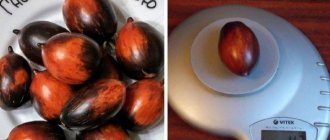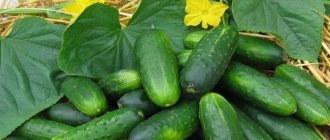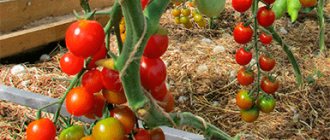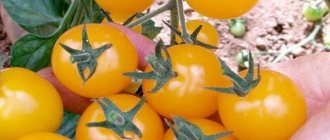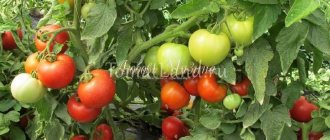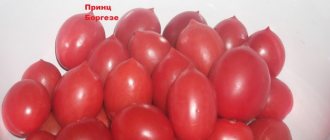Even tomato bushes can look very elegant and aesthetically pleasing. One of these plants is the Katya variety, which is a racemose hybrid. It was developed by Semko-Junior LLC; the registration application was submitted relatively recently - in 2004. The variety was included in the State Register of Breeding Achievements of the Russian Federation in 2007 with permission for cultivation in the North Caucasus region (Republics of Ingushetia, Adygea, Dagestan, Kabardino-Balkarian, North Ossetia-Alania, Crimea, Chechen, Stavropol and Krasnodar territories, Rostov region) . The tomato is recommended for growing in open ground on private farms. But good growth and productivity indicators under film cover enable gardeners from cooler regions to grow this hybrid.
Description of the tomato variety Katya F1
Katya F1 is an early ripening variety, one of the best. The fruits ripen in 80-85 days.
Important! Some sources indicate the tomato variety Katya F1 as ultra-early ripening 75-80 days. According to the State Register, it is classified as early ripening.
High-yielding - 10 kg are collected per square meter, and in greenhouses 1.5 times more. The plant is low-growing, up to 70 cm tall, but requires obligatory garter, especially fragile branches with heavy clusters of fruits.
The clusters contain up to 8 flat-round, smooth, red tomatoes, weighing on average 90 g, but sometimes reaching 130 g. They have a good taste. This variety is a salad variety, but is also excellent for canning, pickling, preparing tomato juice and other preparations. More often they are consumed fresh, because they ripen early, when they are not yet preserved.
The fruits all ripen almost simultaneously, so the main harvest is harvested immediately. These tomatoes last quite a long time. It is recommended to remove slightly unripe fruits for storage and transportation for sale - they ripen quickly, within a few days. After the main harvest, Katya tomatoes still bear fruit, but the number of ovaries is formed much less.
Tomato Katya pink F1
Included in the State Register of the Russian Federation in 2022. While it is still new, it has already gained many fans. In terms of its varietal qualities, yield, agricultural cultivation technology used and other indicators, the characteristics of the tomato Katya rozovaya F1 fully correspond to the main variety.
It differs only in the color and taste of the fruit.
Characteristics
- The fruits of this variety of tomatoes have a round or flat-round shape.
- Weight about 120-130 grams.
- When unripe they are light green, and when ripe they are bright red in color without a greenish spot near the stalk.
- They have a pleasant taste.
- Each fruit has three or four nests.
- The dry matter content is 4.6%.
- These tomatoes do not crack, ripen evenly and are stored for a long time.
- They have a high density, which makes them excellent for transportation.
You can compare the weight of fruits with other varieties in the table below:
| Variety name | Fruit weight |
| Kate | 120-130 grams |
| Bobcat | 180-240 |
| Russian size | 650-2000 |
| Podsinsky miracle | 150-300 |
| American ribbed | 300-600 |
| Rocket | 50-60 |
| Altaic | 50-300 |
| Yusupovsky | 500-600 |
| Premier | 120-180 |
| Honey Heart | 120-140 |
Katya tomatoes can be eaten fresh, and can also be used for canning, preparing tomato paste and juice.
Read on our website: How to get an excellent harvest of tomatoes in open ground? How to grow delicious tomatoes all year round in a greenhouse? What are the agrotechnical subtleties of growing early varieties of tomatoes? What fertilizers for tomatoes should be used to get the best results?
Advantages and disadvantages of the tomato variety Katya F1
Katya tomatoes are popular in private households and are very loved by farmers for their high yield and marketability suitable for commercial cultivation.
Advantages of Katya F1 tomatoes:
- ripen very early;
- excellent taste for a hybrid;
- versatility of use;
- high performance for commercial cultivation - keeping quality, transportability;
- beautiful fruits, do not crack;
- high-yielding variety;
- unpretentiousness;
- resistance to most tomato diseases.
Flaws:
- fragility of stems - they need to be tied up, especially clusters with fruits;
- Phomosis damage is a disease that can be easily prevented by following the rules of agricultural technology (regular loosening of the soil, moderate watering, frequent ventilation of greenhouses), and spraying the bushes with special means.
Harvest and storage
The first ripe tomatoes are picked from the bushes at the end of June. They bear fruit until the end of summer.
Katya tomato fruits are suitable for long-term storage. At the same time, they retain their presentation and do not fade. Thanks to their thick skin, tomatoes do not crack during storage.
Judging by the reviews, Katya tomatoes can withstand transportation over long distances. More than 90% of tomatoes arrive safely at their destination.
Picked green, these tomatoes ripen easily at home and do not lose their taste.
Features of growing seedlings of the Katya F1 variety
To grow Katya F1 tomatoes, you do not need to create any additional care conditions. Agricultural technology is the same as for most other types of tomatoes. Since this is a hybrid, you need to buy new seeds every year, because those collected from the fruits do not have the necessary properties.
Timing for planting seeds
When to plant seeds is determined by the climatic conditions of a given region, taking into account the fact that after sowing the seeds, the seedlings are grown for 2 months, then they are planted in the beds, and after a month the first harvest ripens.
In warm regions, seeds are planted in boxes for seedlings at the end of February. And in colder climates, if there is no greenhouse, bushes are planted in open ground in early June. In this case, seeds for seedlings are sown at the end of March.
There is another way. The seeds are planted in open ground (covered with film) in early May and kept under cover for a month. But then fruiting will only occur in the second half of summer. At the same time, the early ripening properties of this variety are lost.
Seed preparation
Seeds purchased in a store have already been processed - they do not need to be disinfected and then their preparation includes only the following steps:
- calibration - remove damaged and small seeds, check them in a saline solution for germination (those that do not float but remain at the bottom of the container are suitable for sowing);
- soaking - lay the seeds on a wet cloth or foam rubber, and cover with a damp cloth on top; it takes about 18 hours for them to swell; long roots should not be allowed to sprout, because they are brittle;
- hardening - after soaking, seeds are placed in conditions with a low temperature (for example, on the bottom shelf of a refrigerator) so that they better adapt to unfavorable conditions, while the germination of seeds and the immunity of future plants increases.
Soil requirements
To grow seedlings, it is best to buy ready-made soil for tomatoes, which is perfectly balanced in terms of nutrient composition and acidity level.
Some gardeners prefer to prepare the soil themselves.
Composition of soil mixture for seedlings:
- garden soil;
- compost;
- sand;
- peat;
- dolomite flour or wood ash to neutralize soil acidity;
- mineral fertilizers;
- You can add sphagnum moss to improve the breathability of the soil.
Planting scheme
Sowing seeds is done immediately in separate pots or first in containers for subsequent picking into small pots:
- Drainage is placed at the bottom of cups or containers, and soil 5 cm thick is placed on top.
- In containers, each seed is placed 2-3 cm apart from each other.
- sprinkle no more than 2 mm of soil on top.
- Water with water from a spray bottle.
- Cover with film or glass and place in a warm, well-lit place.
Seedling care
To obtain full-fledged seedlings, they provide high-quality care for them.
- The glass lid of the container is opened daily for ventilation, and after the sprouts emerge, they are removed.
- Maintains optimal temperature, lighting and humidity levels in the room.
- Feeding is done periodically.
- Regular moderate watering is provided using a spray bottle.
- Picking is done after the first pair of true leaves appear. The seedlings are watered generously, and then carefully, using a teaspoon, removed from the container and placed in the prepared pot.
- When the plants take root and become stronger, water them in the standard way using a watering can. Water should not be allowed to get on the leaves to prevent diseases.
- Lighting is very important; daylight should be at least 12 hours. In case of its deficiency, phytolamps are used.
Planting seedlings in open ground
For the Katya variety, beds should be selected on loamy or sandy loam areas, the soil should be breathable. If the soil is acidic, then every 3 years you need to add lime or dolomite flour (300-600 g per square meter).
When there is no suitable soil for a garden bed on the site, it can be prepared. River sand (1 bucket per square meter) and compost are added to heavy clay soils. If you add sand and organic matter annually for at least 5 years, the soil will become loamy.
The time for planting Katya tomatoes in open ground depends on the region - in the southern ones it is the beginning of May, and in the more northern ones from early to mid-June. The soil should already be well warmed up and frosts should not return.
The seedlings must first be hardened off. To do this, when the weather is warm, it is taken out into the garden during the day for several hours and placed in partial shade. This procedure significantly increases the adaptation of plants in a new location.
Holes in the garden bed are made with the calculation of 5-6 bushes per square meter. They are pre-watered and then the seedlings are planted. The stems are buried a little more than the level at which they were in the containers. Then the plants are watered and sprinkled with soil on top.
Tomato care
Preparing seedlings is only the first stage towards obtaining a good harvest. It is necessary to follow all the rules for caring for these plants in the future. Proper agricultural technology for caring for this variety requires the fulfillment of several mandatory conditions.
Watering
This ultra-early variety needs moderate regular watering. Each hole requires up to 1 liter of water, but it should not be allowed to stagnate in it. Water should not get on leaves and fruits. The most favorable time is morning and evening.
Watering is most important during the period of adaptation of seedlings to a new place, in the heat, when flowering begins.
Fertilizer
Tomatoes are fed for the first time 10-12 days after planting the seedlings. Organic and mineral fertilizers are used. To 9 liters of water add 1/10 of the volume of mullein and 20 g of superphosphate. This solution is enough for 10 plants. The next 2 feedings are done every 2 weeks. Mineral fertilizers are used.
Stepsoning
It is important to form the bushes correctly. This procedure is necessary to remove excess shoots so that the fruits develop better.
It is advisable to do pinching in the morning. For pruning, use scissors or a knife. Leave one or two stems.
Loosening
This variety is regularly hilled, especially in areas with heavy soil. The first loosening is done 1.5 weeks after planting the seedlings, subsequent ones every 2 weeks. Before this procedure, the tomatoes are watered - hilling with damp soil improves root growth.
Planting and propagation
Starting from the second ten days of March, they begin sowing. The seeds are first placed for several hours in a weak solution of potassium permanganate , then laid out on a damp cloth to swell.
With the appearance of root rudiments, the prepared material should be sown in a box filled with purchased soil or a mixture of garden soil and sand.
Before sowing, the soil is spilled with boiling water or calcined in the oven to destroy overwintering pest larvae.
The soil in the box is compacted, shallow grooves are made with a ruler, the seeds are laid out using tweezers, and sprinkled with soil. Gently sprinkle with boiled water, wrap in polyethylene, and place in a warm place until germination. As soon as the sprouts begin to emerge, the shelter is removed and the boxes are moved closer to the sun.
To prevent Katya tomato plants from stretching out, care should be taken to pick them in a timely manner. Before transplanting, water the seedling boxes, take out the plants along with a lump of earth, and try to shorten the root system by a third.
Dive one plant at a time into a separate container, deepen it to the lower leaves when planting. Slightly compact the soil near the root collar, water with settled water, and provide protection from direct sunlight.
Before planting in open ground conditions, it is necessary to harden the seedlings so that they do not die from temperature changes. They take the plants outside first for a few hours, then leave them for the whole day. As soon as the tomatoes' stems get stronger and change color from greenish to bluish, it's time to start planting in the garden.
Attention! Weak seedlings with thin stems will die after a couple of days if they are not provided with additional film cover. When planting, maintain a distance of 50 cm between plants.
Diseases and pests of tomato variety Katya F1
Tomato Katya F1 is resistant to many diseases typical of tomatoes, except fomoz (brown rot), which can be prevented by using copper oxychloride for spraying. But, unfortunately, it is susceptible to pest attacks, like other garden plants. The root system is affected by mole crickets, May beetle larvae, and wireworms. They are fought with mechanical methods and the use of special poisonous granules, which are added to the holes during planting.
Ground parts are damaged by aphids, whiteflies, and cutworm caterpillars. To combat them, spraying with solutions of special preparations (Aktara) is used.
Mr. Summer Resident recommends: cleaning and using tomato Katya F1
Thanks to its productivity and unpretentiousness, the Katya tomato variety pleases even inexperienced gardeners with an abundance of ripe, tasty tomatoes. Since the bulk of the crop ripens at the same time, it is better to take care of its preservation in advance.
For fresh salads, some tomatoes are left on the bushes until fully ripe. To provide yourself with fresh tomatoes for a longer time, it is better to remove part of the harvest with slightly unripe fruits - they will ripen and be stored for quite a long time.
The flesh of Katya F1 tomatoes is dense, the skin does not crack, so they are excellent for canning. The harvest is harvested when the tomatoes are already ripe, but strong and not overripe.
Comparison of tomato variety Katya F1 with other varieties in the table
Note! How to easily convert c/ha to kg/sq.m? Just divide by 100! For example, the Abakan pink tomato produces 400 centners of commercial fruit per 1 hectare. Which equals 4 kg per square meter. It's simple! Also keep in mind that, as a rule, no more than 3-4 plants are placed on one square meter. In this way, you can calculate the yield from one bush. In the case of Abakan pink, about 1 kg.
| Variety | Ripening period (number of days from full germination to ripening) Productivity of marketable fruits | Short description | Fetus |
| Kate | 80-85 days 326-550 c/ha | Early ripening determinate variety for open ground. Suitable for salads. Marketability 84-90%. | Flat-round, smooth, crack-resistant, red, 80-92 g. Good to excellent taste. |
| Katya pink | 75-80 days 1600-1800 c/ha | Early ripening determinate variety for open ground. Suitable for salads. Marketability 84-90%. | Flat-round, medium density, smooth, pink, 120-130 g. Good taste. |
| Katyusha | 80-90 days 159-533 c/ha (Central Black Earth region), 240-423 c/ha (Far Eastern region). | Mid-season determinate variety for open ground. Suitable for salads. Marketability 65-87%. Heat-resistant, drought-resistant, tolerates waterlogging well. | Flat-round, smooth, red, 90-180 g (up to 335 g). The taste is good and excellent. |
| Broody | 95-105 days 350 c/ha (greenhouse and under film) | Early ripening determinate standard variety for open ground and greenhouses. Suitable for salads. | Flat-round, slightly ribbed, medium density, red, 100 g. Excellent taste. |
| Kostroma | 105-110 days 1350-1500 c/ha | Mid-season determinate variety for greenhouses. Requires gartering and shaping. Suitable for salads, whole-fruit canning, processing into tomato products. | Flat-round, slightly ribbed, glossy, red or orange, 80-150 g. Good taste, sweet and sour. |
| Far North | 100-110 days 190 c/ha | Early ripening determinate standard variety for open ground and greenhouses. Suitable for salads and whole fruit canning. | Round, smooth to slightly ribbed, medium density, red, 60-80 g. Good taste. |
| Little Red Riding Hood | 85-90 days 180 c/ha | Early ripening determinate standard variety for greenhouses. Suitable for salads. | Round, smooth, soft, red, 15-20 g. Excellent taste. |
| A gardener's dream | 95-100 days 630 c/ha | Ultra-early ripening determinate variety for open ground and greenhouses. Requires gartering and shaping. Suitable for salads. | Flat-round, smooth, medium density, red, 80 g. Good taste. |
| Raspberry Liana (not in the State Register) | 85-90 days 700 c/ha | Early-ripening (ultra-early-ripening) determinate standard variety for open ground and greenhouses. Suitable for salads, canning and processing into tomato products. | Round, smooth, red, 65-90 g. Good taste. |
| Matador | 105-110 days 500-600 c/ha | Early ripening determinate variety for open ground. Suitable for salads and whole fruit canning. | Cylindrical, smooth, dense, red, 100 g. Excellent taste. |
| Michurinsky (not in the State Register) | 90-95 days 800-1000 c/ha | Early ripening determinate variety for open ground and greenhouses. Suitable for salads, canning, processing into tomato products (ketchup and sauce). | Round, smooth, red, 80-100 g. Taste good to excellent. |
| Snowdrop | 80-90 days 600 c/ha | Early ripening determinate variety for open ground. Requires gartering and shaping. Suitable for salads and pickling. Drought resistant. | Flat-round, slightly ribbed, red, 120-130 g. Good taste. |
For reference, how to determine the timing of tomato ripening:
According to the ripening period, tomatoes are usually divided into super-early, early, mid-early, late, and very late. True, the State Register provides for another classification, into ultra-early ripening, early ripening, mid-early, mid-ripening, mid-late and late ripening. It is also worth noting that the days from full germination to ripening in the State Register very often differ from the classification itself. For example, the Agata variety is indicated as early ripening, while it is also added that ripening occurs on days 98-113 after full germination. And the Adeline variety, which is also classified as mid-season, ripens in fewer days, namely 82-109. Thus, we can conclude that there is no need to pay special attention to the type of variety, although we will present it; it is more important to look specifically at the days from full germination to ripening. Also keep in mind that this number of days depends, among other things, on growing conditions and may vary. Conditional terms: super early - 75-95 days, early - 95-115, mid early - 110-120, late - 120-130, super late - 130-150 and more.
Description
The plant is of a determinate type, that is, not tall, which makes it easier to care for. In open ground the height is 60 - 70 cm, in closed ground - 1 meter. The stem of the variety is of medium thickness, the internodes are short. The tomato bush is not too branched, with medium foliage. Katya's leaves are petiolate, green, of normal size and type, with a slightly corrugated surface. The inflorescence is simple, without branches. The first fruit cluster is laid over the 5th - 6th leaf, the subsequent ones are formed after 1 - 2 leaves. The brushes are well filled, each containing up to 7 - 8 ovaries. The stalk is articulated; the place where the stalk attaches to the tomato is wide.
Katya's fruits have good density, a smooth surface, and a shape from round to flat-round. In terms of size, they can be called one-dimensional. The average weight of the fruit of the variety, according to the State Register, is 80 - 92 grams, according to the originator - the weight is from 110 to 130 grams. The skin is dense, not thick, glossy. An unripe tomato is light green, without a spot at the stalk. When ripe it turns red. The pulp is aromatic, which is rare in hybrids, fleshy, tender. The taste is sweet and sour; gardeners note that for early tomatoes the taste is more than good. The State Register describes the taste of tomato as good and excellent. The number of seed nests is only 3 - 4 pieces. 100 grams of freshly squeezed juice contains 4.6% dry matter, 2.4% total sugar.

